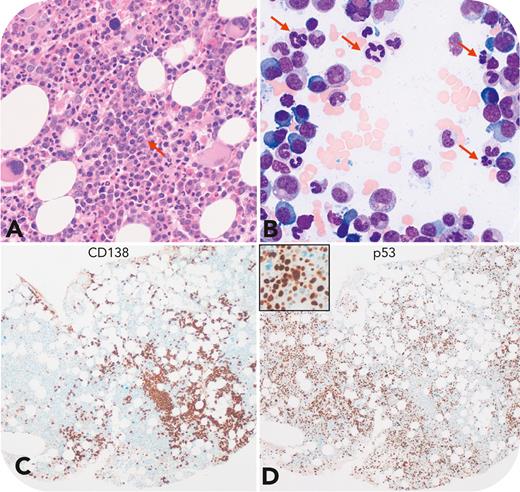A 76-year-old man with an 11-year history of plasma cell myeloma presented for follow-up. He received therapies including cyclophosphamide/lenalidomide, radiation, and autologous stem cell transplant. Peripheral blood showed immunoglobulin G lambda monoclonal protein, hemoglobin 7.7 g/dL, absolute neutrophil count 2.3 × 109/L, and platelets 136 × 109/L. Bone marrow (BM) revealed 20% lambda light-chain–restricted plasma cells (panel A: original magnification ×200, hematoxylin and eosin stain), and multilineage dysplasia (panel B: original magnification ×400, Wright-Giemsa stain). BM karyotype was complex: 45,XY,−5,+8,add(16)(p13.1),−18[20], and next-generation sequencing on bulk BM aspirate detected DNMT3A W893∗ (44%), TP53 K145Q (43%), and V272M (44%). Immunostains of CD138 and p53 demonstrated strong p53 staining in background hematopoietic cells but not in the plasma cell aggregates (panels C-D: original magnification ×40, inset in D original magnification ×200). Findings are consistent with a concurrent myelodysplastic neoplasm with biallelic TP53 inactivation, postcytotoxic therapy (WHO-5)/myelodysplastic syndrome with mutated TP53, therapy-related (ICC).
Myeloid neoplasms may arise after prior cytotoxic chemotherapy and/or large-field radiation therapy, commonly associated with TP53 mutations, and complex karyotype with frequent 5q/7q/17p loss. However, detection of TP53 mutation(s) in BM aspirates cannot definitively establish such an association when myeloid neoplasm and nonmyeloid neoplasm coexist. Although single-cell sequencing or next-generation sequencing performed on sorted cell populations aid in the distinction, they are costly and unavailable for routine clinical practice. Paired immunostains (eg, CD138 with p53) offer a practical, cost-effective alternative for assessing TP53-mutant cellular population, particularly with aggregate-forming nonmyeloid neoplasm.
For additional images, visit the ASH Image Bank, a reference and teaching tool that is continually updated with new atlas and case study images. For more information, visit https://imagebank.hematology.org.


This feature is available to Subscribers Only
Sign In or Create an Account Close Modal